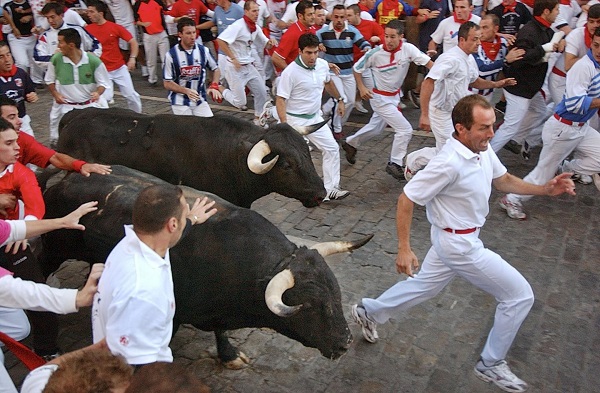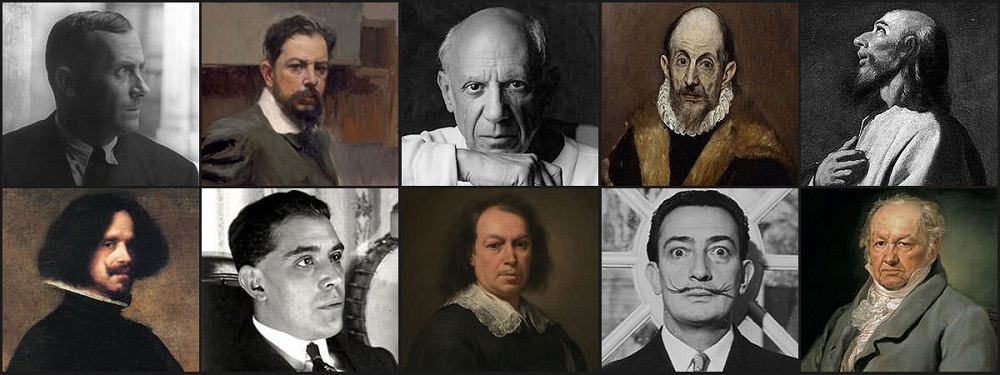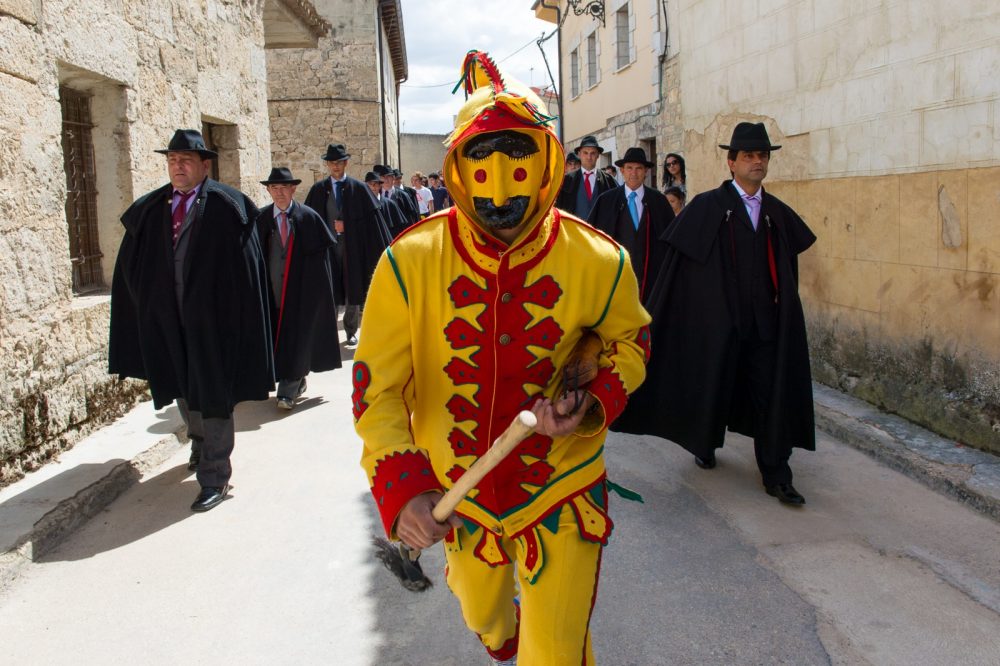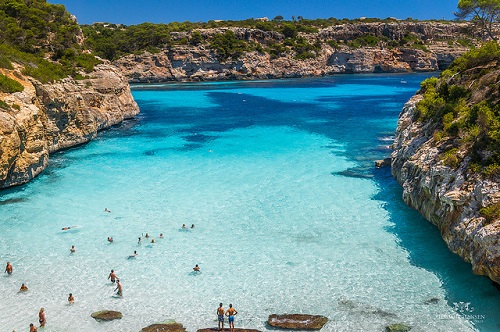The most famous festival in Spain is the annual running of the bull in Pamplona.it held each July drawing the attention of thousands of tourists from different countries around the world. The festival takes place from the 7th to 14th July in honor of the San Fermin festival.
The origins:
The origin of this festival comes from the need to transfer the bulls from the fields outside the city where they were reproduced to the bullring where that would be killed in the evening.
This tradition dates back the 14th century in northeastern Spain while conducting the cows in order to sell them at the market, men would try to hurry the process by speeding their cows using tactics of fear and excitement. After years this practice of the transference and speeding changed into a competition as young adults would attempt to compete in front of the bulls, when the popularity of this tradition spread the world it became official and stands to this day.
‘’El Encierro’’ The Bull Run:

The Pamplona begins every morning at 8 a.m. by giving the first alert to confirm to the runners that the corral gate is open in Santo Domingo, in addition, the runners dressed in white with a red handkerchief around their necks pray to San Fermín. Then a second rocket signals that all six bulls have been liberated. The third and fourth rockets are alarmed that all of the crowd has joined the bullring and its corral respectively, marking the end of the event.
The Bull Run is normally included of the six bulls to be fought in the afternoon, six guiders that run in herds with the bulls, and three more others come behind the herd to encourage and guide any resistant bulls to continue along the route to the bullring.
Furthermore, the stretch of the run is 825 meters it goes through four streets of the city from Santo Domingo and over the Ayuntamiento Square continuing down to the Mercaderes and Estafeta. Besides, the most dangerous part of the Bull Run approaches as there’s a closed curve ruling into Estafeta which is the lengthiest stretch of the run.
The bull running map:

1) Calle de Santo Domingo:
The bull running begins from Santo Domingo, which is the most dangerous part because of the crowds and chaos to the Plaza Del Ayuntamiento then a left turn into Mercaderes.
2) Called de Mercaderes:
One of the shortest prolongs of the run known as ‘’la Curva’’ or ‘’dead man’s curve’’ leading to a right turn into Calle Estafeta.
3) Calle de la Estafeta:
The Call de la Estafeta is the longest part of the course, where the bulls are fast.
4) Telefonica and Callejon:
Telefonica is the short stretch coming over the left off Estafeta, Telefonica leads to Callejon which is the final entrance to the bullring.
Watching the Bull running:

You can watch the bull running from different views:
Street: You can stand behind the barriers that mark the route of the Bull Run, but you need to arrive by around 6.30am to get the best places on the top of the fence directly overlooking the run. Also, another good position is in front of the museum in Santo Domingo, where there isn’t a barrier.
Private Balconies: A great place to watch the bull running is to find a balcony overlooking the Bull Run and try to meet someone who invites you into their terrace.
Plaza de Toros: another option is to go to the bullring and watch the end as the bulls and some petrified runners arrive at the arena.
What is not allowed in the Bull Run?
- People under 18 years old, who must not run or participate.
- Passing police fences placed to ensure that the run goes off smoothly. Standing in places along the route that have been clearly prohibited by the municipal police force.
- Don’t leave the doors of shops or entrances to apartments open along the route.
- While the Bull Run try to not be under the effects of drugs or alcohol or any other improper manner.
- Dressing in suitable clothes or footwear for the run.
- Urging the bulls are attracting their attention in any manner along the route of the run or in the bullring.
- Running in reverse towards the bulls or running behind them.
- Mistreat the bulls and stopping them from moving.
- Taking photographs from the fences or inside the run, without any authorization.
Other Things to Do in Pamplona:

If you are looking to get away from the foolishness of the nine-day festival, Pamplona is also a worthwhile destination in itself offers fun alternatives that aren’t quite as intense as the festival and the running of the bulls, besides, you can discover beautiful places while visiting Pamplona.
- Museum of Navarra:
The museum of Navarra is lodged in an old pilgrim hospital, is a beautiful historic building with a fascinated facade that dates back to 1556. The museum comprised 34 different rooms displays at various collections of archaeological objects and fine arts like old Moorish treasures, ancient Roman artifacts, and medieval religious paintings.
- Plaza del Castillo:
This large public square is the principal feature of Pamplona built in 1844 was a stage for bullfights, it is considered as the heart of the city and a hub of social life. The Plaza del Castillo is used for public events, parades, and markets.
Moreover, It comprises charming balconies buildings line the square, and a gazebo in the center offers a pleasing shaded place for relaxation. Also At the southwest corner of the plaza is the Palacio de Navarra established in 1847 and extended in 1932, which is now the Diputación Foral.
- Ayuntamiento:
The Ayuntamiento is a magnificent town hall building dates back to 17th-century and it is considered as an impressive monument and charming small square of Pamplona, in addition, it located northwest of the Plaza del Castillo on the Plaza Consistorial, and the building has a majestic Baroque facade of ochre sandstone crowned by lions bearing coats of arms and a trumpet-blowing angel.
- Plaza de Toros and Bullfighting Monument:
The Plaza de Toros is the Bullring of Pamplona, situated on the Paseo de Hemingway, named in honor of Ernest Hemingway who was fascinated of bullfighting. the bullfighting Monument of the Bull is a unique work represents a dramatic bullfight, the monument has 11 meters in length was crafted from bronze designed by Bilbao sculptor Rafael Huerta Celaya in 1994.
- Taconera gardens:
The Taconera Park is the most attractive green space in Pamplona. Situated around the antiquated walls of the Old Town. The gardens combine Romantic style and formal French elements reminiscent of the gardens at the Versailles Palace in France, which cover 90,000 square meters. It is constituted by different types of flowers and trees as well as the peaceful open space and a small zoo for children comprises swans, ducks, deer and peacocks.
Images sources : Pamplona-tours – Tripsavvy – Science20 –


 Top 10 Most Famous Spanish Artists and their Arts
Top 10 Most Famous Spanish Artists and their Arts
 El Colacho, the Baby Jumping Festival in Murcia Spain
El Colacho, the Baby Jumping Festival in Murcia Spain
 Discover The Most Beautiful Places In Mallorca, Spain
Discover The Most Beautiful Places In Mallorca, Spain